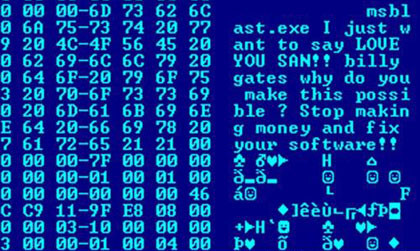|
Memory-scraping Malware
Memory-scraping malware or RAM Scrapping malware is a malware that scans the memory of digital devices, notably point-of-sale (POS) systems, to collect sensitive personal information, such as credit card numbers and personal identification numbers (PIN) for the purpose of exploitation. Operation The magnetic stripe of payment cards hold three different data tracksTrack 1, Track 2 and Track 3. The POS RAM scrapers were created to implement the use of expression matches to gain access and collect the Track 1 and Track 2 card data from the RAM process memory. Some RAM scrapers use the Luhn algorithm to check the validity of card data before exfiltration. See also * Point-of-sale malware Point-of-sale malware (POS malware) is usually a type of malicious software (malware) that is used by cybercriminals to target point of sale (POS) and payment terminals with the intent to obtain credit card and debit card information, a card's tr ... References Malware Theft {{malware- ... [...More Info...] [...Related Items...] OR: [Wikipedia] [Google] [Baidu] |
Malware
Malware (a portmanteau for ''malicious software'') is any software intentionally designed to cause disruption to a computer, server, client, or computer network, leak private information, gain unauthorized access to information or systems, deprive access to information, or which unknowingly interferes with the user's computer security and privacy. By contrast, software that causes harm due to some deficiency is typically described as a software bug. Malware poses serious problems to individuals and businesses on the Internet. According to Symantec's 2018 Internet Security Threat Report (ISTR), malware variants number has increased to 669,947,865 in 2017, which is twice as many malware variants as in 2016. Cybercrime, which includes malware attacks as well as other crimes committed by computer, was predicted to cost the world economy $6 trillion USD in 2021, and is increasing at a rate of 15% per year. Many types of malware exist, including computer viruses, worms, Trojan ho ... [...More Info...] [...Related Items...] OR: [Wikipedia] [Google] [Baidu] |
Point Of Sale
The point of sale (POS) or point of purchase (POP) is the time and place at which a retail transaction is completed. At the point of sale, the merchant calculates the amount owed by the customer, indicates that amount, may prepare an invoice for the customer (which may be a cash register printout), and indicates the options for the customer to make payment. It is also the point at which a customer makes a payment to the merchant in exchange for goods or after provision of a service. After receiving payment, the merchant may issue a receipt for the transaction, which is usually printed but can also be dispensed with or sent electronically. To calculate the amount owed by a customer, the merchant may use various devices such as weighing scales, barcode scanners, and cash registers (or the more advanced "POS cash registers", which are sometimes also called "POS systems"). To make a payment, payment terminals, touch screens, and other hardware and software options are available ... [...More Info...] [...Related Items...] OR: [Wikipedia] [Google] [Baidu] |
Luhn Algorithm
The Luhn algorithm or Luhn formula, also known as the " modulus 10" or "mod 10" algorithm, named after its creator, IBM scientist Hans Peter Luhn, is a simple checksum formula used to validate a variety of identification numbers, such as credit card numbers, IMEI numbers, National Provider Identifier numbers in the United States, Canadian Social Insurance Numbers, Israeli ID Numbers, South African ID Numbers, Swedish National identification numbers, Swedish Corporate Identity Numbers (OrgNr), Greek Social Security Numbers (ΑΜΚΑ), SIM card numbers, European patent application number and survey codes appearing on McDonald's, Taco Bell, and Tractor Supply Co. receipts. It is described in U.S. Patent No. 2,950,048, granted on August 23, 1960. The algorithm is in the public domain The public domain (PD) consists of all the creative work to which no exclusive intellectual property rights apply. Those rights may have expired, been forfeited, expressly waived, or may ... [...More Info...] [...Related Items...] OR: [Wikipedia] [Google] [Baidu] |
Point-of-sale Malware
Point-of-sale malware (POS malware) is usually a type of malicious software (malware) that is used by cybercriminals to target point of sale (POS) and payment terminals with the intent to obtain credit card and debit card information, a card's track 1 or track 2 data and even the CVV code, by various man-in-the-middle attacks, that is the interception of the processing at the retail checkout point of sale system. The simplest, or most evasive, approach is RAM-scraping, accessing the system's memory and exporting the copied information via a remote access trojan (RAT) as this minimizes any software or hardware tampering, potentially leaving no footprints. POS attacks may also include the use of various bits of hardware: dongles, trojan card readers, (wireless) data transmitters and receivers. Being at the gateway of transactions, POS malware enables hackers to process and steal thousands, even millions, of transaction payment data, depending upon the target, the number of devices a ... [...More Info...] [...Related Items...] OR: [Wikipedia] [Google] [Baidu] |
Malware
Malware (a portmanteau for ''malicious software'') is any software intentionally designed to cause disruption to a computer, server, client, or computer network, leak private information, gain unauthorized access to information or systems, deprive access to information, or which unknowingly interferes with the user's computer security and privacy. By contrast, software that causes harm due to some deficiency is typically described as a software bug. Malware poses serious problems to individuals and businesses on the Internet. According to Symantec's 2018 Internet Security Threat Report (ISTR), malware variants number has increased to 669,947,865 in 2017, which is twice as many malware variants as in 2016. Cybercrime, which includes malware attacks as well as other crimes committed by computer, was predicted to cost the world economy $6 trillion USD in 2021, and is increasing at a rate of 15% per year. Many types of malware exist, including computer viruses, worms, Trojan ho ... [...More Info...] [...Related Items...] OR: [Wikipedia] [Google] [Baidu] |

